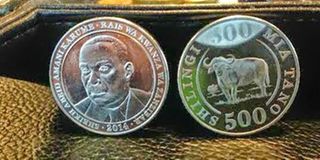BoT says investigating dubious Sh500 coins

A coin of Sh500. PHOTO | COURTESY
What you need to know:
- The Bank of Tanzania says it is investigating coins with characteristics that appear inauthentic, although the BoT has not officially confirmed that specific samples forwarded to it are actually counterfeit
Dar es Salaam. The Bank of Tanzania (BoT) is investigating the presence of some Sh500 coins in circulation which have marks that are different from the usual ones.
“We have received your letter. We are working on the matter,” the BoT governor, Prof Florens, said in response to enquiries by The Citizen’s stablemate Mwananchi.
The BoT introduced Sh500 coins in 2014 to replace the fast-wearing Sh500 notes.
The coins are round, grooved on the edges and silver in colour.
Among the notable features, they have the face of the head of the first Zanzibar President Abeid Amani Karume on the front while on the back, they have the face of a buffalo in a park.
But during recent weeks, some coins with somewhat different features from the 2014 ones have found their way into the market.
Among the notable differences is the face of President Karume whereby the moustache looks more protruding in the ones that have just found their way into the market.
Besides, the animal on the back - which is supposed to be a buffalo in a park - looks like a completely different creature.
The coins are also not as silvery shining as the ones that were introduced in 2014.
However, they are being found in the market, mostly with the likes of commuter bus conductors, pay toilet operators and those who ‘sell coins for change’ in some commuter bus stops. That means they also make their way into pockets of a number of other individuals.
“I realised the mismatch four months ago and since then, I do not receive them whenever a commuter bus conductor brings them to me. They have been bringing them almost each and every day and I tell them to give me a different one,” said Mr George Migoba, who runs a pay toilet service in one of the busy locations in Dar es Salaam.
He said he recognises the coins by the way they look, saying the weight also looks lighter than the one that he is used to.
Ms Jasmine Peter who works with Udart said she has been receiving the coins on several occasions. “I have been asking myself as to when did the government introduce new Sh500 coins?” she asked.
Mr Rashid Kassim, who ‘sells coins for change’ at a commuter bus stop, said it was quite difficult for one to clearly differentiate the coins, noting that he has personally delivered them to a number of conductors and nobody seems to mind.
The then Finance and Planning minister, Dr Phillip Mpango, warned in January 2020 that production and supply of counterfeit money constitutes economic sabotage and attracts strict legal action.
In September, 2020, the BoT said it had taken 10 people to court in to answer criminal charges relating to fake currency notes.
Prof Luoga said the ten people were nabbed in Dar es Salaam, Mwanza, Arusha, Moshi and Mbeya.
“The 10 include people found in possession of fake currency notes, as well as people who were found with machines used in the printing of counterfeit notes,” Prof Luoga said in a circulated video clip in September 2020.
That was the second time in less than a year that the banking sector’s regulator was warning against the proliferation of fake notes in circulation.
In December last year, Prof Luoga called for tougher penalties against persons convicted of printing and/or circulating fake currency notes.
He spoke after the police said they had arrested three suspects and seized counterfeit currency notes of various nations purportedly worth about Sh500 million in all, warning that if the situation left unchecked, fake money could adversely affect the economy at the individual and national levels.
He warned that if BoT’s mandate of controlling money circulation is illegally impacted, it would fuel inflation and bring the economy to its knees.
The five-year jail term for persons convicted of possessing fake notes irrespective of how they obtained the counterfeits is not a deterrent.
According to the Permanent Secretary in the Ministry of Finance and Planning, Mr Emmanuel Tutuba, any person engaged in the production of counterfeit money could be sued for forgery of government documents. “The laws are explicit. They can be sued even under the Anti-Money Laundering Act,” he told Mwananchi recently.
The Anti-Money Laundering Act, 2006 is explicit and clear, covering even person who enjoy proceeds of a predicate offence, including those who know or ought to know or ought to have known that the property… or participates in, associates with, conspires to commit, attempts to commit, aids and abets, or facilitates and counsels the commission of any money laundering or counterfeiting.
Those found guilty are sentenced to a fine or up to five years in prison or to both.





